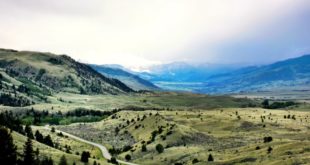Iowa State University’s Diane Debinski has been studying the meadows in the Greater Yellowstone Ecosystem of the Rocky Mountains since 1992. She has found that if the area’s climate becomes drier as the earth’s temperature climbs, it could lead to a change in the types of plants and animals that live there.
To study the potential effects of climate change, Debinski has been conducting large-scale, long-term, observational studies of the plant and insect communities in 55 montane (mountainous) meadows in the ecosystem.
Her conclusion: shrubs that grow in the drier meadows (such as sagebrush) increased, while flowering plants decreased in number. Shrubs from drier meadows do not provide as much food for animals as flowering plants that grow in wetter meadows.
This may result from the way the plants get water, Debinski said. Shrubs generally have deeper roots and can obtain water from deeper in the soils. Flowering plants generally get water from nearer the surface. These types of changes could have important implications for wildlife in the montane meadows Debinski studied.
“In these meadows, as water became more scarce, that means less moisture for the plants,” she said. “The flowering plants don’t grow as well and therefore don’t provide as much food to the animals. These types of changes in the plants could affect populations of elk, bison, as well as many other smaller animals, including insects.”
Since there were fewer flowering plants in the drier years, pollinators such as butterflies were also becoming scarce in several of the plots Debinski and her colleagues studied. Two species of butterflies that live in the wetter meadows actually disappeared from her sampling sites for a year, but were observed again in later years.
Debinski plans to publish the results of her butterfly research soon.
Because there are six types of meadows, from wet to dry, Debinski was also able to examine which meadow type was most vulnerable to change.
The results showed that medium-moisture meadows — neither wet nor dry — are in the biggest danger of change.
“If wet meadows get a little drier, they’re still wet,” she said. “If dry meadows get a little drier, they are still dry. But the meadows with a medium amount of wetness are the ones that may be changing most.”
It may not seem like it, but the Greater Yellowstone Ecosystem is more fragile than we think: break the chain and there are ramifications down the food chain. Lose the flowers and the butterflies leave. The butterflies leave and there’s less in the way of pollination. Lose the pollination and the growth of new plants slows down. Fewer new plants means less food for grazing animals.
And so on.
And so on.
We’ve also set up a free Twitter account so you can receive updates on the device of your choice.
 Yellowstone Insider Your Complete Guide to America's First National Park
Yellowstone Insider Your Complete Guide to America's First National Park





